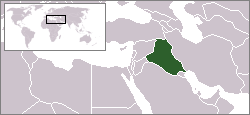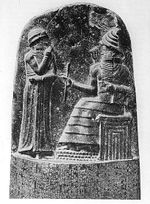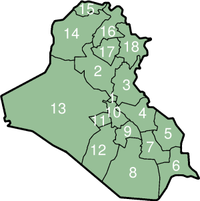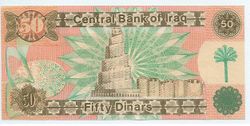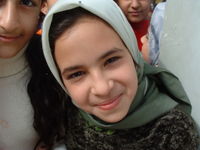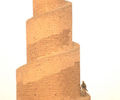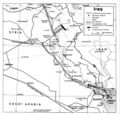Iraq
2007 Schools Wikipedia Selection. Related subjects: Countries; Middle Eastern Countries
| جمهورية العراق Jumhuriyat Al Iraq كۆماری عێراق Komara Iraqê Republic of Iraq |
|||||
|
|||||
| Motto: Arabic: الله أكبر ( Transliteration: Allahu Akbar) ( Translation: "God is Great") |
|||||
| Anthem: Mawtini (new); Ardh Alforatain (previous) |
|||||
| Capital | Baghdad |
||||
|---|---|---|---|---|---|
| Largest city | Baghdad | ||||
| Official languages | Arabic, Kurdish, ( Assyrian (Syriac) and Iraqi Turkmen ) | ||||
| Government | Parliamentary democracy | ||||
| - President | Jalal Talabani | ||||
| - Prime Minister | Nouri al-Maliki | ||||
| Independence | |||||
| - from the Ottoman Empire | October 1, 1919 | ||||
| - from the United Kingdom | October 3, 1932 | ||||
| Area | |||||
| - Total | 438,317 km² ( 58th) 169,234 sq mi |
||||
| - Water (%) | 1.1 | ||||
| Population | |||||
| - 2005 estimate | 28,807,000 ( 40th) | ||||
| - Density | 66/km² ( 125th) 171/sq mi |
||||
| GDP ( PPP) | 2005 estimate | ||||
| - Total | $89.8 billion ( not ranked) | ||||
| - Per capita | $3,600 ( not ranked) | ||||
| Currency | Iraqi dinar ( IQD) |
||||
| Time zone | ( UTC+3) | ||||
| - Summer ( DST) | ( UTC+4) | ||||
| Internet TLD | .iq | ||||
| Calling code | +964 | ||||
| 1↑ The Kurds use Ey Reqîb. 2↑ The capital of the Kurdistan Autonomous Region is Arbil. |
|||||
The Republic of Iraq (conventional short form: Iraq) (Arabic: العراق translit: 'al-‘Irāq, Kurdish: عيَراق), is a country in Southwest Asia encompassing most of Mesopotamia as well as the northwestern end of the Zagros mountain range and the eastern part of the Syrian Desert. It shares borders with Kuwait and Saudi Arabia to the south, Jordan to the west, Syria to the northwest, Turkey to the north, and Iran to the east. It has a very narrow section of coastline at Umm Qasr on the Persian Gulf.
Name
There are several suggestions for the origin of the name of Iraq; - one dates back to the Sumerian city of Uruk (or Erech). Another suggestion is that Iraq comes from the Aramaic language, meaning "the land along the banks of the rivers." Another suggestion is Iraq is a reference to the root of a palm tree, as they are numerous in the country.
Under the Persian Sassanid dynasty, there was a region called "Erak Arabi" referring to part of the south western region of the Persian Empire, which now is part of southern Iraq. Al-Iraq was the name used by the Arabs themselves for the land since the 6th century.
Pronunciation of Iraq - (1) [ɪ.ˈɹɑ(ː)k], (2) [ɪ.ˈɹæk], (3) [aɪ.ˈɹæk] (1) is the preferred pronunciation in most dictionaries, and the only pronunciation listed in the Oxford English Dictionary. MQD lists (2) first. (3) is considered uneducated or unacceptable to some. It is the pronunciation which is least like the original Arabic pronunciation [ʕiˈrɑːq].
History
Ancient history
Iraq was historically known as Mesopotamia, which literally means "between the rivers" in Greek. This land was home to the world's first civilization, the Sumerian culture, followed by the Akkadian, Babylonian, and Assyrian cultures, whose influence extended into neighboring regions as early as 5000 BC. These civilizations produced the earliest writing and some of the first sciences, mathematics, laws and philosophies in the world, making the region the centre of what is commonly called the " Cradle of Civilization". Ancient Mesopotamian civilization dominated other civilizations of its time.
In the sixth century BC, the region became a part of the Persian Empire under Cyrus the Great, before it was conquered by Alexander the Great and remained under Greek rule for nearly two centuries. A Central Asian tribe of Iranian peoples called Parthians then annexed the region, followed by the Sassanid Persians until the 7th century.
Beginning in the seventh century AD, Islam spread to what is now Iraq. The prophet Mohammed's cousin and son-in-law moved his capital to Kufa "fi al-Iraq" when he became the fourth caliph. The Umayyads ruling from Damascus in the 7th century ruled the province of Iraq.
Baghdad, the capital of the Abbasid Caliphate, was the leading city of the Arab and Muslim world for five centuries. In 1258, Baghdad was devastated by the Mongols and was later occupied by the Ottoman Turks. Ottoman rule over Iraq lasted until the Great War (World War I) when the Ottomans sided with Germany and the Central Powers. During World War I, the Ottomans were driven from much of the area by the United Kingdom during the dissolution of the Ottoman Empire.
Modern history
British occupation
During World War I, the British and French divided the Middle East in the Sykes-Picot Agreement. The British would control Mesopotamia. At the end of World War I, the League of Nations granted the area to the United Kingdom as a mandate. It was formed out of three former Ottoman vilayets (regions): Mosul, Baghdad and Basra. However, for three out of four centuries of Ottoman Turkish rule, the vilayets of Baghdad, Mosul, and Basra were administered from Baghdad. During the British mandate, the country was ruled by British colonial administrators who used the British armed forces to put down rebellions against the government. They selected the Hashemite king, Faisal, who had been forced out of Syria by the French, to be their client ruler.
Iraq was granted independence in 1932 by the urging of King Faisal, though the British retained military bases and transit rights for their forces in the country. King Ghazi of Iraq ruled as a figurehead after King Faisal died in 1933, while Iraq suffered from military coups (dictatorships) until he died in 1939. Iraq was invaded by the United Kingdom in 1941, for fears that the government of Rashid Ali might cut oil supplies to Western nations and because of his strong leanings to Nazi Germany. A military occupation followed after the restoration of the Hashemite monarchy, and the occupation ended on October 26, 1947. The rulers of the country during the occupation and the remainder of the Hashemite monarchy period were the autocratic prime minister Nuri al-Said who also ruled from 1930-1932 and the advisor 'Abd al-Ilah to the king Faisal II.
Hashemite monarchy
The reinstalled Hashemite monarchy lasted until 1958, when it was overthrown through a coup d'etat by the Iraqi Army, known as the 14 July Revolution. The coup brought Brigadier General Abdul Karim Qassim to power. He withdrew from the Baghdad Pact and established friendly relations with the Soviet Union but his government lasted only until 1963, when it was overthrown by Colonel Abdul Salam Arif. Salam Arif died in 1966 and his brother, Abdul Rahman Arif, assumed the presidency. In 1968, Rahman Arif was overthrown by the Arab Socialist Ba'ath Party. This movement gradually came under the control of Saddam Hussein al-Majid al Tikriti who acceded to the presidency and control of the Revolutionary Command Council (RCC), then Iraq's supreme executive body, in July 1979, killing off many of his opponents in the process.
Saddam Hussein
Saddam's rule lasted throughout the Iran-Iraq War (1980–1988) (in which the United States, Soviet Union, and France backed Saddam after 1982, at least in the open, see Iran Contra Affair), a war that ended in stalemate. In the late 1980s, Saddam Hussein's regime launched the al-Anfal campaign (Spoils of War), which led to the disappearance of tens of thousands of Kurds (182 000 is the number given by Kurdish authorities for the year 1988 alone) in northern Iraq when the military razed thousands of villages, launched poison gas attacks and rounded up men, women and children before shooting them or burying them alive in mass graves.
In 1990 Iraq invaded Kuwait resulting in the Gulf War and United Nations economic sanctions imposed at the urging of the U.S. The economic sanctions were designed to compel Saddam to dispose of weapons of mass destruction (WMDs). Critics estimate that over 500,000 Iraqi children died as a result of the sanctions. The U.S. and the UK declared no-fly zones over Kurdish northern and Shiite southern Iraq to oversee the Kurds and southern Shiites.
In July 2005, Hussein, and seven co-defendants were processed in Baghdad for the 1982 mass killing of 148 residents of the Shi'ite town of Dujail, a retaliation prompted by an assassination attempt against Saddam. The men faced charges of war crimes and crimes against humanity. On Sunday, November 5th, 2006, Saddam, his half-brother and former intelligence chief Barzan Hassan, and former chief judge of the Revolutionary Court Awad Bandar, were found guilty and sentenced to death by hanging. Taha Yassin, a former vice president of Iraq, was sentenced to life in prison. Abdullah Kadhem Ruwaid, Ali Dayem Ali, and Misher Abdullah Ruwaid were sentenced to 15 years each, and Mohammed Azzawi Ali, a former Dujail Baath Party official, was acquitted because of insufficient evidence against him.
Saddam's death sentence is subject to an automatic appeal.
According to the New York Times, Saddam's verdict and sentence would "come under review by the nine-judge appellate chamber of the trial court. There is no time limit for the appeal court's review, but Iraqi and American officials who work with the court said that the earliest realistic date for Saddam Hussein's execution, assuming it stood up to review, would be next spring." Iraqi law requires executions to take place within 30 days of the end of the appeal process; however it also forbids the executions of people aged over 70 years old, a status Saddam Hussein acquires on 28 April 2007.
Occupation by Coalition Forces
Iraq was invaded in March 2003 by a United States-organized coalition with the stated reasons that Iraq had not abandoned its nuclear and chemical weapons development program according to United Nations resolutions. The justifications given for invasion included purported Iraqi government links to Al Qaeda, claims that Iraq had weapons of mass destruction, the opportunity to remove an oppressive dictator from power, and the bringing of democracy to Iraq. A range of other possible motives include control over Iraqi oil fields, a desire to make amends for failing to overthrow Saddam during the Gulf war, revenge for Saddam's effort to assassinate former President George Bush, and creating a counterbalance to a nuclear-armed Iranian theocracy.
The United States established the Coalition Provisional Authority to govern Iraq. Government authority was transferred to an Iraqi Interim Government in 2004 and a permanent government was elected in October 2005. Over 140,000 Coalition troops remain in Iraq in order to assist the government, although there is increasing media speculation on a complete handover to Iraqi government forces within the next 12 months.
Judging the success of the occupation
Of the stated or assumed goals of the occupation, the coalition forces have been successful in removing Saddam Hussein from his position as a claimed oppressive dictator and in bringing democracy to Iraq. However, the occupation failed in its stated goal to destroy the country' weapons of mass destruction, and to date no use-ready weapons of mass destruction have been found by coalition forces although some chemical shells were found that were left over from the Iran-Iraq War. It is also probable that there was little or no pre-existing al-Qaeda presence in Iraq, where it had been suppressed by the secular Iraqi government. After the invasion, al-Qaeda was however able to exploit the insurgency to establish its organization in the country in concurrency with a Sunni-led insurgency and sectarian violence. In 2006, Foreign Policy Magazine named Iraq as the fourth most unstable nation in the world. In October 2006 former U.S. Secretary of State James Baker referred to the situation in Iraq as being "a helluva mess".
Loss of life following occupation
According to a recent epidemiologic study by Burnham et al in The Lancet medical journal, 655,000 Iraqis have died directly or indirectly as a result of the U.S. invasion of Iraq in 2003. The 95% confidence interval of this estimate spans from 393,000 to 943,000 dead. These numbers have been controversial and were immediately denounced both politically and within the statistical analysis community. The methodology used by Burham et al, known as cross-sectional population-based cluster sampling, is respected among epidemiologists for estimating mortality rates in war-torn countries. However, questions have arisen regarding the sufficiency of the sample size for the extrapolations made in the Lancet survey.
The Lancet estimate is significantly higher than estimates from other organizations. In 2004, the United Nations Development Program (UNDP) used 2,200 cluster points of 10 interviews each for a total sample of 21,688, to arrive at their estimate of between 18,000 and 29,000 violent deaths during the first year after the invasion. The 2006 Lancet survey used 47 cluster points, and a total of 1,849 households, to arrive at their estimate of 112,000 total excess Iraqi deaths for the first year and on until August 2004 (a period of a year and 4 months).
In an opinion piece published in the Wall Street Journal on October 18, 2006, Steven E. Moore, of Gorton Moore International, wrote "What happens when you don't use enough cluster points in a survey? You get crazy results when compared to a known quantity, or a survey with more cluster points. There was a perfect example of this two years ago. The UNDP's survey, in April and May 2004, estimated between 18,000 and 29,000 Iraqi civilian deaths due to the war. This survey was conducted four months prior to another, earlier study by the Johns Hopkins team, which used 33 cluster points and estimated between 69,000 and 155,000 civilian deaths--four to five times as high as the UNDP survey, which used 66 times the cluster points."
Concerning the 2004 UNDP study, Appendix C of the 2006 Lancet article supplement states: "Working for the U.N. Development Program, the highly regarded Norwegian researcher Jon Pederson led a survey that recorded between 18,000 and 29,000 violent deaths during the first year of occupation. The survey was not focused on deaths, but asked about them over the course of lengthy interviews that focused on access to services. While this was more than twice the rate recorded by IBC at the time, Pederson expressed concern for the completeness and quality of the data in a newspaper interview last year. The surveys reported in The Lancet were focused solely on recording deaths and count about two and a half times as many excess deaths from all causes over the same period."
The 2006 Lancet article supplement also states: "In 2004 we estimated that somewhere in excess of 100,000 deaths had occurred from the time of the invasion until August 2004. Using data from the 2006 survey to look at the time included in the 2004 survey, we estimate that the number of excess deaths during that time were about 112,000. That these two surveys were carried out in different locations and two years apart from each other yet yielded results that were very similar to each other, is strong validation of both surveys. ... In the news media coverage of the 2004 survey report, much was made of the wide confidence intervals, which is a statistical technique that was frequently misunderstood. With the much larger sample of the 2006 survey, the confidence intervals are narrowed significantly."
The Iraq Body Count project, as of October 19 2006, reports a range of between 43,937 and 48,783 civilian deaths as a result of the U.S. invasion. Iraq Body Count relies solely upon passive surveillance of officially reported deaths in generating this number. The authors of The Lancet study criticize this methodology, writing "Aside from Bosnia, we can find no conflict situation where passive surveillance recorded more than 20% of the deaths measured by population-based methods. In several outbreaks, disease and death recorded by facility-based methods underestimated events by a factor of ten or more when compared with population-based estimates." Such a tenfold gap between the findings of active versus passive reporting is in line with the findings of The Lancet study.
Government
Politics
Iraq was under Ba'ath Party rule from 1968 to 2003; in 1979 Saddam Hussein took control and remained president until 2003 after which he was unseated by a US-led invasion.
On October 15, 2005, more than 63% of eligible Iraqis came out across the country to vote on whether to accept or reject the new constitution. On October 25, the vote was certified and the constitution passed with a 78% overall majority, with the percentage of support varying widely between the country's territories. The new constitution had overwhelming backing among the Shia and Ķurdish communities, but was overwhelmingly rejected by Sunnis. Three majority-Sunni provinces rejected it ( Salah ad Din with 82% against, Ninawa with 55% against, and Al Anbar with 97% against).
Under the terms of the constitution, the country conducted fresh nationwide parliamentary elections on December 15 to elect a new government. The overwhelming majority of all three major ethnic groups in Iraq voted along ethnic lines, turning this vote into more of an ethnic census than a competitive election, and setting the stage for the division of the country along ethnic lines.
Iraqi politicians have been under significant threat by the various factions that have promoted violence as a political weapon. The ongoing violence in Iraq has been incited by an amalgam of religious extremists that believe an Islamic Caliphate should rule, old sectarian regime members that had ruled under Saddam that want back the power they had, and Iraqi nationalists that are fighting against what they view as a foreign occupation.
Minority politics
There are a number of ethnic minority groups in Iraq: Kurds, Assyrians, Mandeans, Iraqi Turkmen, Shabaks and Roma. These groups have not enjoyed equal status with the majority Arab populations throughout Iraq's eighty-five year history. Since the establishment of the "no-fly zones" following the First Gulf War, the situation of the Kurds has changed as they have established their own autonomous region. The remainder of these ethnic groups continue to suffer discrimination on religious or ethnic grounds.
Administrative divisions
Iraq is divided into eighteen governorates (or provinces) (Arabic: muhafadhat, singular - muhafadhah, Kurdish: پاریزگه Pârizgah). The governorates are subdivided into qadhas (or districts).
|
|
Geography
At 168,743 sq.mi (437,072 km²), Iraq is the 58th-largest country in the world, after Morocco. It is comparable in size to the US state of California, and somewhat larger than Paraguay.
Large parts of Iraq consist of desert, but the area between the two major rivers (Euphrates and Tigris) is fertile, with the rivers carrying about 60 million cubic metres (78 million cu. yd) of silt annually to the delta. The north of the country is largely mountainous, with the highest point being a 3,611 metres (11,847 ft) point, unnamed on the map opposite, but known locally as Cheekah Dar (black tent). Iraq has a small coastline with the Persian Gulf. Close to the coast and along the Shatt al-Arab (known as arvandrūd: اروندرود among Iranians) there used to be marshlands, but many of these were drained in the 1990s.
The local climate is mostly desert with mild to cool winters and dry, hot, cloudless summers. The northern mountainous regions experience cold winters with occasional heavy snows, sometimes causing extensive flooding. The capital of Baghdad is situated in the centre of the country, on the banks of the Tigris. Other major cities include Basra in the south and Mosul in the north.
While its proven oil reserves of 112 billion barrels ranks Iraq second in the world behind Saudi Arabia, the United States Department of Energy estimates that up to 90 percent of the country remains unexplored. Unexplored regions of Iraq could yield an additional 100 billion barrels. Iraq's oil production costs are among the lowest in the world. However, only about 2,000 oil wells have been drilled in Iraq, compared to about 1 million wells in Texas alone.
Economy
Iraq's economy is dominated by the oil sector, which has traditionally provided about 95 percent of foreign exchange earnings. In the 1980s financial problems caused by massive expenditures in the eight-year war with Iran and damage to oil export facilities by Iran led the government to implement austerity measures, borrow heavily, and later reschedule foreign debt payments. Iraq suffered economic losses from the war of at least US$100 billion. After hostilities ended in 1988, oil exports gradually increased with the construction of new pipelines and restoration of damaged facilities. A combination of low oil prices, repayment of war debts (estimated at around US$3 billion a year) and the costs of reconstruction resulted in a serious financial crisis which was the main short term motivation for the invasion of Kuwait.
On November 20, 2004, the Paris Club of creditor nations agreed to write off 80% ($33 billion) of Iraq's $42 billion debt to Club members. Iraq's total external debt was around $120 billion at the time of the 2003 invasion, and had grown by $5 billion by 2004. The debt relief will be implemented in three stages: two of 30% each and one of 20%.
At the end of 2005, and in the first half of 2006, Iraq implemented a restructuring of about $20 billion of commercial debt claims on terms comparable to that of its November 2004 Paris Club agreement (i.e. with an 80% writeoff). Iraq offered to its larger claimants a U.S. dollar denominated bond maturing in 2028. Smaller commercial claimants received a cash settlement of comparable value.
Reconstruction
Reconstruction in Iraq has been difficult, due to the amount of damage done to the basic infrastructure of the region; the influx of US invasion and the strife among factions within the native populace. Large-scale reconstruction efforts have had, at best, limited success.
Demographics
A July 2005 estimate of the total Iraqi population is 26,074,906.
Seventy-five to eighty percent of Iraq's population are Arabs; the other major ethnic groups are the Kurds at 15-20%, Assyrians, Iraqi Turkmen and others (5%), who mostly live in the north and northeast of the country. The Kurds, Assyrians, and Turkmen differ from Arabs in many ways, including culture, history, clothing, and language. Other distinct groups are Persians and Armenians (possible descendants of the ancient Mesopotamian culture). About 20,000–50,000 Marsh Arabs live in southern Iraq.
Arabic and Kurdish are official languages. Assyrian and Turkmen are official languages in areas where the Assyrians and Iraqi Turkmen are located respectively. Armenian and Persian are also spoken but to a lesser extent. English is the most commonly spoken Western language.
Most of Iraqis are Shi'ite Muslims (55%), and Sunni represent one third of the total population (33%) made up of mostly Arabs and Kurds. Ethnic Assyrians (of the Chaldean rite) account for most of Iraq's sizable Christian population, along with Armenians. Bahá'ís, Mandaeans, Shabaks, and Yezidis also exist. Most Kurds are Sunni Muslims, although the Faili (Feyli) Kurds are largely Shi'a.
Ethnic Composition:
- Ethnic groups: Arab, 75–80%; Kurdish, 15-20%; Turkoman, Assyrian or other 5%.
- Religions: Muslim, 97%; Christian or other, 3%.
Proportions: There are no official figures available, mainly due to the highly politically charged nature of the subject. Source: Britannica: Shi'a 60%, Sunni 40% Source: CIA World Fact Book: Shi'a 60%-65%, Sunni 32%-37%
- Shi'a: mostly Arabs some Turkmen and Faili Kurds almost all are Twelver school
- Sunni: composed of Arabs who are Hanafi school and Kurds who are Shafi school
Culture
In the most recent millennium, what is now Iraq has been made up of five cultural areas: Kurdish in the north centered on Arbil, Sunni Islamic Arabs in the centre around Baghdad, Shi'a Islamic Arabs in the south centered on Basra, the Assyrians, a Christian people, living in various cities in the north, and the Marsh Arabs, a nomadic people, who live on the marshlands of the central river. Markets and bartering are the common form of trade.
Music
Iraq is known primarily for an instrument called the oud (similar to a lute) and a rebab (similar to a fiddle); its stars include Ahmed Mukhtar and the Assyrian Munir Bashir. Until the fall of Saddam Hussein, the most popular radio station was the Voice of Youth. It played a mix of western rock, hip hop and pop music, all of which had to be imported via Jordan due to international economic sanctions. Iraq has also produced a major pan-Arab pop star-in-exile in Kazem al Saher, whose songs include Ladghat E-Hayya, which was banned for its racy lyrics.
Gallery
|
Tigris River near Mosul |
|||
|
Boat on the Euphrates River |


